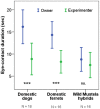Man's underground best friend: domestic ferrets, unlike the wild forms, show evidence of dog-like social-cognitive skills
- PMID: 22905244
- PMCID: PMC3419687
- DOI: 10.1371/journal.pone.0043267
Man's underground best friend: domestic ferrets, unlike the wild forms, show evidence of dog-like social-cognitive skills
Abstract
Recent research has shown that dogs' possess surprisingly sophisticated human-like social communication skills compared to wolves or chimpanzees. The effects of domestication on the emergence of socio-cognitive skills, however, are still highly debated. One way to investigate this is to compare socialized individuals from closely related domestic and wild species. In the present study we tested domestic ferrets (Mustela furo) and compared their performance to a group of wild Mustela hybrids and to domestic dogs (Canis familiaris). We found that, in contrast to wild Mustela hybrids, both domestic ferrets and dogs tolerated eye-contact for a longer time when facing their owners versus the experimenter and they showed a preference in a two-way choice task towards their owners. Furthermore, domestic ferrets, unlike the wild hybrids, were able to follow human directional gestures (sustained touching; momentary pointing) and could reach the success rate of dogs. Our study provides the first evidence that domestic ferrets, in a certain sense, are more dog-like than their wild counterparts. These findings support the hypothesis that domestic species may share basic socio-cognitive skills that enable them to engage in effectively orchestrated social interactions with humans.
Conflict of interest statement
Figures



References
-
- Archer J (1997) Why Do People Love Their Pets? Evolution and Human Behavior 18: 237–259.
-
- Hare BA, Tomasello M (2005) Human-like social skills in dogs? Trends in Cognitive Sciences 9: 439–444. - PubMed
-
- Miklósi Á, Topál J, Csányi V (2004) Comparative social cognition: what can dogs teach us? Animal Behaviour 67: 995–1004.
-
- Soproni K, Miklósi Á, Topál J, Csányi V (2002) Dogs ’ (Canis familiaris) Responsiveness to Human Pointing Gestures. Journal of Comparative Psychology 116: 27–34. - PubMed
-
- Hare BA, Brown M, Williamson C, Tomasello M (2002) The domestication of social cognition in dogs. Science 298: 1634–1636. - PubMed
Publication types
MeSH terms
LinkOut - more resources
Full Text Sources

